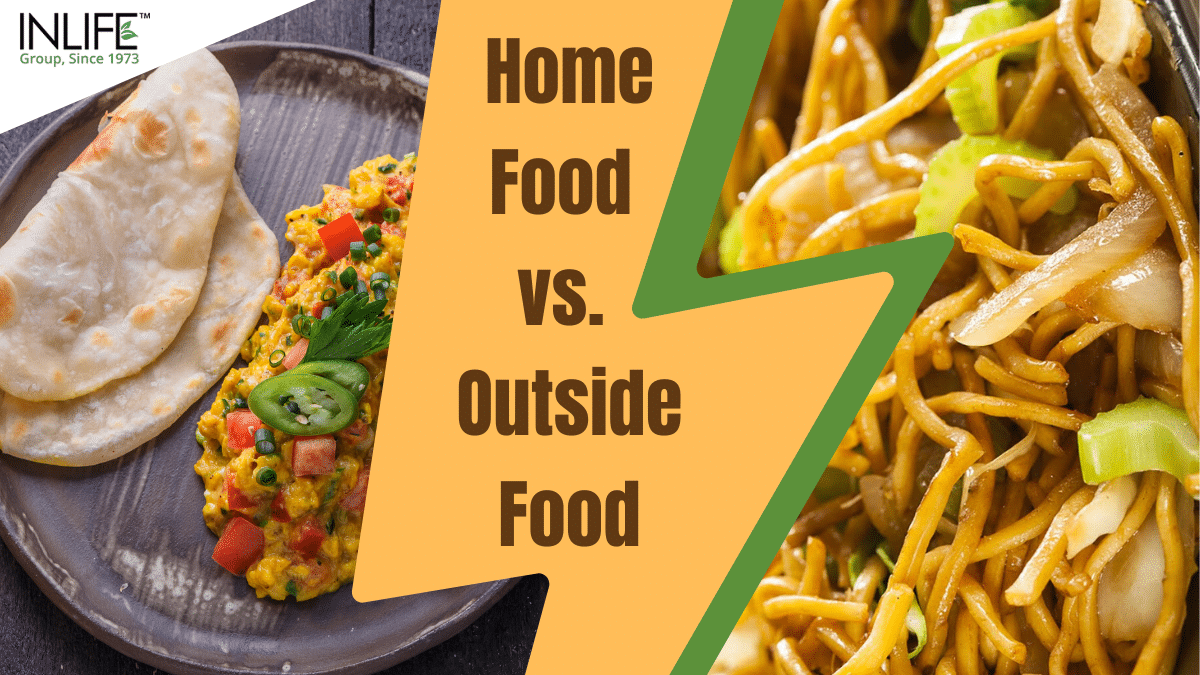Diet & Nutrition, Exercise, Health, Lifestyle
Home Food vs. Outside Food
It is very rightly said that the key to a person’s heart goes through his stomach. If you are new to eating home food, you might first experience a kind of detox phase. As your taste buds are already accustomed to the exaggerated flavours of chemically processed foods.
You suddenly might expect everything to taste sweeter than it is, or you might also experience that most of the dishes that you taste are under-spiced as your body has previously learned more normal levels of salt and sugar intake.
Eating at home may not sound as glamorous as eating out frequently but eating home-cooked food has its own benefits. Generally, dishes out at restaurants might taste over greasy or in some cases, everything might taste a little too sweet.
Also, as your skills grow and you master cooking, you will be able to tailor healthy meals to work with your particular preferences and favourite flavours. This exactly means less compromise and more control.
You Can Have Complete Control Over The Ingredients
When you eat at home, which means you can buy fresh ingredients and single-ingredient products from a store that allows you to control the amounts that you cook with.
You even have the liberty to use as many fats and oils as you are comfortable with. You will surely be able to use salt for spicing without worrying about it being too much. While food is cooked at home it will also help to show how unnecessary added sugars are in most of your dishes.
Each of your meal can inexpensively be well-rounded with the addition of produce, protein, starch, and fruit. Basically, it is ordering the side items in the restaurants that make your entree into a full meal cost you a hefty price.
This also indicates that you can tailor dishes to be just what you like, so you don’t have to bother about an eating establishment not carrying your favourite salad dressing. You can also add your favourite vegetables in almost every dish and even better you can combine whatever themes you want to experiment with. You can choose what to eat on the basis of the following points:
Lifestyle
Cooking at home means that you can choose to make meals that work best for your lifestyle choices.
Vegetarians And Vegans
They are more likely to cook food at home due to the difficulty of finding a wide variety of vegetarian dishes in most of the restaurants.
Athletes, Bodybuilders And Fitness Enthusiasts
They basically prefer home-cooked food as they have a particular training regimen and its crucial for them to fix their balanced meals.
Home-Cooked Meals Benefit The Environment
Since cooking at home allows us to choose local food, including farmers market-sourced vegetables and grass-fed beef while cutting down on wasteful packaging.
Physiology
People often need to begin making their own meals after experiencing physiological problems –
Generally processed food exceed their dietary need for sugar and a low-sugar diet is required by those who are diabetic or prediabetic. Hence, cooking at home is the surest way to eliminate unnecessary added sugars from your diet.
It could be very difficult to find restaurants that offer gluten-free diets and celiacs. These diets alternately require grains as opposed to wheat, such as rice, quinoa, almond flour and cornbreads.
This kind of flour is used in restaurants as a thickener for soups and sauces and breading for pan-fried foods.
People who are at the risk of heart disease along with high blood pressure require low sodium diets. Also, people who are accustomed to consuming processed foods face a lot of difficulties as these processed food items use sodium to enhance flavour while they also act as a preservative. So the best thing you can do to cut down on your sodium intake is to make food for yourself at home.
Location
To the best of our knowledge, the farmer’s market are an amazing place to find minimally processed foods. On the other hand, it decreases the carbon footprint of the transportation of your food as well as help farmers and small business owners in your area.
Another reason why you should have home-cooked food is that the secluded towns and areas may not have as many options for healthy eateries. In the case of the larger city, they have come up with the idea of farm-to-table restaurants.
Still, there are many places where restaurants chains are available that serve chemically processed, preservative-packed and high-sodium foods.
How Restaurant Food Is Different From Home-cooked Food?
Outside food basically wants to keep our taste buds excited. This food contains preservatives and chemicals and are quite high in sodium, fat, and sugar than what we would generally allow ourselves to eat.
What Makes All Those Fast Food?
Fast foods are mostly produced and chemically altered in a factory setting. Generally, in the factory, these foods are pumped with artificial and natural flavours. This is what keeps the food standardized and taste exactly the same every time.
When it comes to fast food or processed foods they are frozen, shipped, stored and reheated when they are ready. Also, in the speedy kitchen of the fast-food restaurants, all the cooking processes and times are exactly the same.
Moreover, fast foods are higher in fats, sugar and salt as compared to the fresh foods, thus making them altogether higher in calories. Outside foods are also lower in fibre due to the production process which means that they make us feel less full than they should.
Common Components Of Fast Foods And Processed Foods:
Salt
In processed foods, salt is the most commonly used preservative in it. No doubt it inhibits bacteria growth by restricting water to their cells but it also introduces harmful amounts of sodium into our bodies. If checked, you will find salt in every item of fast food even in the sweet ones. Salt is responsible for making the food more palatable and is used as a seasoning in hamburgers, bacon, chicken and bread as well.
High Fructose Corn Syrup (HFCS)
The most common fast food sweetener found in fast foods and processed foods is HFCS. It also considered the most harmful component. This artificial sugar mainly involves altering the glucose sugar present in cornstarch into fructose.
HFCS is broadly used as this is much cheaper to process than sucrose (cane sugar), while also being a lot sweeter. It is also used as a preservative that helps to extend the shelf life of foods.
In other words, HFCS is an added sugar that is unnecessary in most foods, giving them a high caloric value and low nutritional yield.
Food colour
It is a common saying in the food industry that people eat with their eyes. If you consider, the freshest foods have the most vibrant natural colour. On the other hand, fast food basically needs a helping hand with food colouring as these foods are heavily preserved, produced in mass and frozen.
Thus food colouring has become a necessary part of fast foods’ ability to compete. While you can find the usage of red food colouring is most common, the most often used food colouring ingredient is actually caramel colour.
Additives that are commonly used are yellow no. 5 and yellow no.6 which are used to make cheese look golden-yellow. Whereas red additives are used to brighten cherries, jellies and pastries. Basically these caramel colours are made from heating carbohydrates but it doesn’t add to a food’s flavour profile.
Monosodium Glutamate (MSG)
While MSG is generally associated with Chinese restaurants but apparently it is used by almost all fast-food restaurants as a flavour enhancer. Practically, MSG has no flavour of its own but it is used to strengthen the flavour of ingredients such as chicken or beef.
MSG is mass-manufactured through a fermentation process using carbohydrates that include starch, sugar beets, sugar cane or molasses. Basically, this ingredient has been under scrutiny for many years. Nevertheless, it has been found that it is quite harmful primarily for those who eat it on an empty stomach and for those with severe asthma. Thus, the additional sodium of the MSG can put individuals at risk for high blood pressure and other heart problems.
Vitamin B3
Vitamin B3 or Niacin is an added nutrient that is normally found in fruits and vegetables. These natural vitamins do not form the part of the usual fast-food meals since mass manufacturing generally eliminates these important nutrients. The fast-food or the processed food industry answer this by replacing the nutrients with enhancement and fortification.
More often bread in fast food are commonly enriched with riboflavin, folic acid, iron, and niacin. Although this looks like a positive for fast food, there is no way for food manufacturers to completely replace all of the lost nutrients.
Soybean Oil
Soybean oil is used extensively in producing margarine, pastries, cookies, soups and non-dairy creamers. It is also used for deep frying most of the things.
Coming to the normal soybean oil, it is full of saturated fats which is better for our bodies. Nevertheless, this also means that soybean oil doesn’t have a long shelf-life. Thus, to work around this, the mass food production industry, hydrogenate soybean oil and convert it into trans fat. New and better versions of soybean oil which is partially hydrogenated use fewer unsaturated fats.
Processed Foods And How Are They Harmful?
Most of the food items that we eat now are processed in some or the other way. And certainly, most of the food is repackaged for sale. Therefore, single-ingredient foods that are meant to be cooked at home are good for us.
The main problem in chemical processing is that chemically processed foods are made from refined and artificial ingredients. While they claim to be enriched with vitamins and minerals, that enrichment is incapable of giving us all the nutrients that we generally get from fresh or natural foods.
Processed Foods Usually Have Unwanted Added Sugar
If you feel that you are having a lot of sugar in your diet, it is most likely coming from the processed foods. And to be very specific its not only about cookies and ice creams. Sugar is literally added into basic foods such as bread products and salad dressings.
Processed Foods Are Quite Addictive
Be it salty or sweet, processed foods make us binge on them and want more. These food addict our brains with their intensified flavours thus letting us indulge in overconsumption.
Artificial Ingredients Often Include Chemicals
When we mention about artificial ingredients that mostly include preservatives, colours, flavours and texture enhancing products.
Processed Foods And Refined Carbohydrates
Refined carbohydrates are basically simple carbs that are quickly broken down thereby depositing all the sugar in the bloodstream. They also hold lesser nutrients and fibre that your body can get from the whole carbohydrates.
You must be cautious of highly processed foods that contain whole grains since over pulverized or fiberless whole grains will have the same empty carb problem.
Refined Carbohydrates Are Easily Digested
When refined carbohydrates are digested quite easily we tend to eat more than actually needed. In this scenario, we burn fewer calories in digestion than we would have burned in case of whole food.
Processed Foods Are Low In Fibre
Fibre is nothing but a prebiotic that helps the good bacteria in our stomach. Fibre is considered to aid regularity in the digestive system. Lack of these fibres in processed foods increases the absorption of carbs and makes us always feel hungry.
Thus, eating at home is simply a kind of investment in your health. While by eating food out frequently, you can contract illnesses that include weight gain, high blood pressure, insulin resistance, etc. These all might potentially prove to be expensive health complications and might require long-term medications.
Home-cooked meals and healthy eating are often stigmatized as being more expensive and even considered as only attainable to a luxury lifestyle. This is absolutely a myth since eating healthier has no significant cost over eating processed foods.


